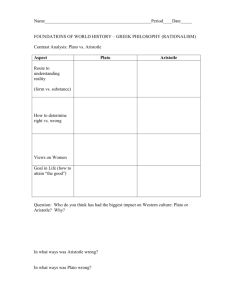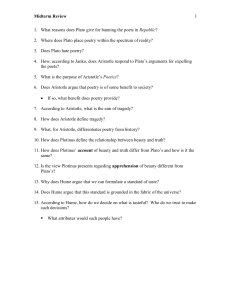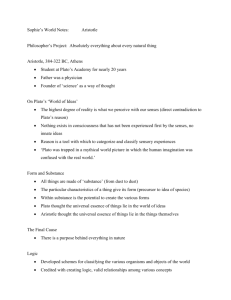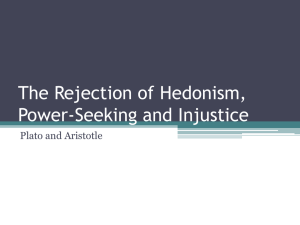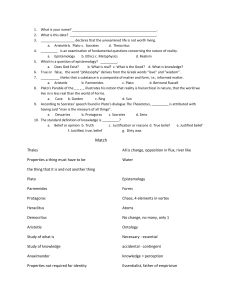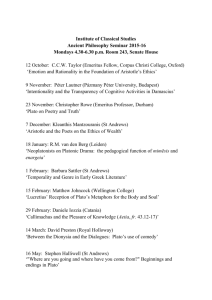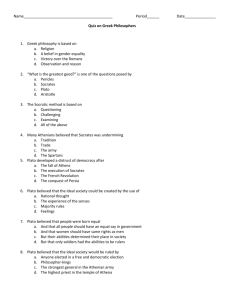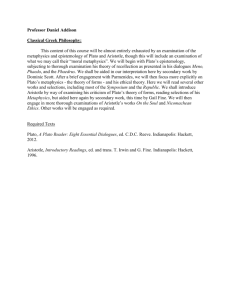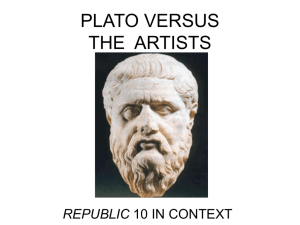Republic - Denis Dutton
advertisement
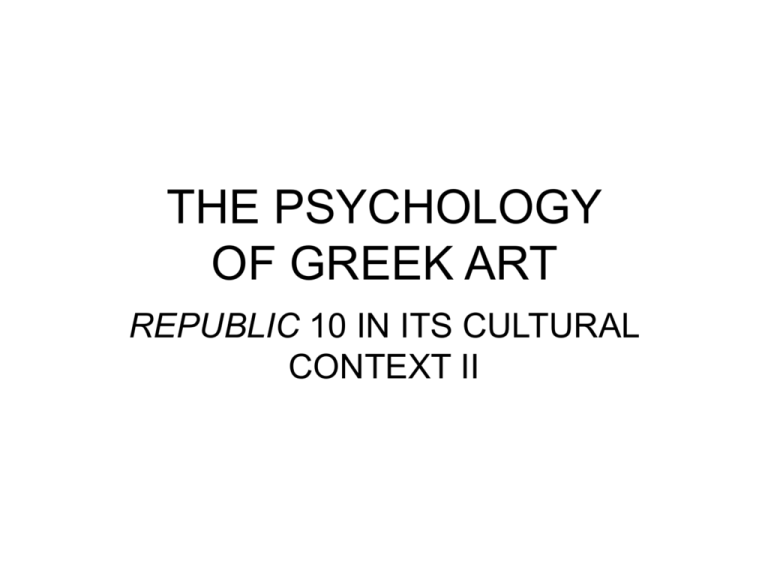
THE PSYCHOLOGY OF GREEK ART REPUBLIC 10 IN ITS CULTURAL CONTEXT II OVERVIEW • Alternative views to Plato in Rep. 10 • Poets, philosophers, sophists, et al. on art • Greek art in context – Art and the viewer • Art and text in combination to produce effect • Emotions, politics, erotics of Greek art – Psychological power – Art as rhetoric – Plato’s bugbears…? PLATONIC AESTHETICS I • Inseparable from – – – – – – Education Ontology Epistemology Psychology Ethics & Justice Politics • Issues addressed elsewhere in Republic – Plato addresses legacy of poets: Homer, Hesiod, et al. – His intellectual precursors – Poets seen as teachers of religion, ethics, law REPUBLIC 10: Critique of Mimetic Painting & Poetry • Mimesis now rejected – Psychology, epistemology, education – Theory of Forms – Outlined in books 4-9 of Rep. • Painting used as extensive analogy for mimetic poetry • Both media subject to Plato’s – – – – Ontology Epistemology Psychology Ethics & Justice REPUBLIC 10 (595-603): On Painting & Poetry • Ontology – Painting = mimesis phantasmatos – Imitation of an appearance – Couch example and invocation of Forms • Epistemology – Painters and poets = ignorant, so, too, their public – 3 removes from truth – User/maker/imitator argument • Psychology – Painting plays havoc with our senses – Seductive, erotic, magical language used – Epithumetikon vs Logistikon REPUBLIC 10 (603-607): On Epic Poetry & Tragedy • Epistemology – Homer is no general – No victories recorded – How reliable a source for war??? • Psychology – Meter, harmony, music beguiles us – Seductive, erotic, magical language used (cf. painting) – Grief: tragedy, etc. panders to ‘irrational’, emotive elements in us REPUBLIC 10 (605c-607): ‘The Greatest Charge’ • It corrupts the best of us (cf. painting) • NB its emotive power • pleasure in sympathising with sufferings of others • People assimilate Homeric tragic characters’ behaviour to own lives • the more you indulge these emotions, the more you encourage them Poets destabilise our psychological ‘order’ Justice = Psychological order Mimetic poets to be banned (!) SOME RESPONSES Plato assumes depiction = endorsement • does not allow for critical distance of poet and audience • Achilles presented as problematic figure in first 2 lines of Iliad Plato does not allow for psychological complexity • demands simple didactic message • how reasonable is this? Plato ignores moments in Homer of heroic restraint of emotion: • Achilles and Priam again • Plato very selective in critique SOME OTHER ANCIENT VIEWS Poetry a source of pleasure in and of itself: Homer, Hesiod Gorgias the orator and Sophist (c. 480-375 BC) • intense emotional power of poetry and artworks not necessarily bad (Encomium of Helen) • on cleverness of audience (B23) recognition of artistic fiction • tragedy involves deceit, cleverness and justice! • Platonic objections turned on their head! • Cf. Dissoi Logoi on painting and tragedy SOME OTHER ANCIENT VIEWS Aeschines and Isocrates (orators, active c. 410-350 BC) provide opposite evidence to Plato • people do not assimilate tragic emotions in their own lives • recognise artistic fictions and emotions Democritus of Abdera (c. 465-380 BC) • other people’s sufferings can make us count our blessings and help • poet composes very beautifully under inspiration: enthousiasmos • Homer has a divine nature & designs a ‘cosmos’ of all kinds of words SOME OTHER PLATONIC VIEWS • Plato expresses different views on art & poetry elsewhere – Phaedrus: Plato admires mania of poet – Apology: invokes Achilles as his model! – Plato is himself a supreme literary artist (and knows it!) – Ion: poetry beautiful and true • But poets/rhapsodes irrational • Operate under inspiration = ENTHOUSIASMOS – Republic 10: poet = imitator only • No inspiration • Plato on poetry: Curb Your Enthousiasmos ARISTOTLE Aristotle: Plato’s greatest student and greatest critic: Poetics defends art and poetry Aristotle Contemplating Homer (Rembrandt, c. Jacques-Louis David, Oath of the Horatii (1784) Pablo Picasso, Guernica (1937) Norman Lindsay (1879-1969) Francesco de Goya, 3rd of May 1808 Goya, Disasters of War Some Greek writers on art • Polyclitus – – – – • • • • • • Sculptor active c. 450-410 BC Author of ‘Canon’ A technical treatise Philosophical overtones? Empedocles Hippias Gorgias Democritus Apelles Euphranor, et al. – Sources in Pliny – Vitruvius Polyclitus, Doryphorus c. 445 BC Anavysos Kouros, c. 530 BC • accompanied by inscription • in hexameter (Homeric) verse • ‘Stay by the grave of Kroisos the dead man and pity him whom once in the forefront of battle raging Ares destroyed.’ • emotive response required • Homeric/heroic connotations • cf. Thersites as opposite • erotic; cf. Tyrtaeus New York Kouros; Cleobis & Biton Anavysos Kouros, c. 530 BC Dexileos Monument, c. 390 • Inscription: ‘Dexileos, son of Lysanias from Thorikos, born under the archonship of Teisandros [=414/13 BC] , died under the archonship of Euboulides at Corinth as one of five cavalrymen.’ ‘Phrasikleia’, c. 540 & Peplos Kore, c. 525 Inscription: ‘Grave marker of Phrasikleia. I will always be called maiden (Kore), having obtained that name instead of marriage.’ Cf. Homeric hymn to Demeter Persephone as Kore Berlin Kore, c. 580 Hegeso Monument, c. 400 BC Ilissos Monument, c. 360 BC White-ground lekythos, c. 440 Exekias, Suicide of Ajax, c. 530 Sacrifice of Iphigeneia, Pompeii, c. 100 BC •In Aeschylus’ Agamemnon, Iphigeneia is compared to a painting ‘Strikes her killers with an arrows of pity from her eyes’ Cf. Timanthes’ painting and grades of pity on characters Zeus & Ganymede, c. 480 Nike of Paionios, c. 420 BC Temple of Athena Nike, c. 410 Classical Athens: Art, Eros & Power Acropolis, Athens Theatre of Dionysos Cf. Pericles: ‘Look on her power and become a lover of the city.’ (Thucydides) Myron, Discobolos, (orig.c. 460) •Lucian (2nd century AD): Lover of Lies • •Discussion of statue as combination of different poses •Sequence of movements •Not actual appearance, but conveys kinetic energy A form of artistic ‘deceit’? Roman copy Apatê? Cf. Other Media •Lucian (2nd century AD) • Lover of Lies •Discussion of statue as combination of different poses •Sequence of movements •Not actual appearance, but conveys kinetic energy A form of artistic ‘deceit’? Panathenaic amphora, c. 530 BC Apatê? Artemision god, Zeus (?), c. 460 • • • • Summary: Art as heightened representation Heroising aspects Erotics & desire; pity & longing: pothos ‘deceptive’ aspects (apatê); a ‘sweet sickness’ Cultivates specific modes of viewing – – – – A visually persuasive & powerful image Not just an imitation of an appearance Gorgianic aesthetics anticipates Aristotle Cf. Plato’s reaction in Republic 10! • Culture of artistic fiction and emotional engagement with art objects – Anticipates much in Aristotle’s Poetics ARISTOTLE Aristotle: Plato’s greatest student and greatest critic: Poetics defends art and poetry Aristotle Contemplating Homer (Rembrandt, c.
